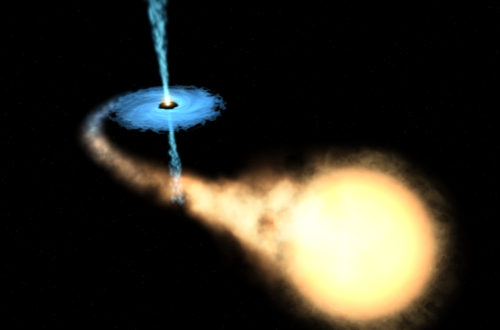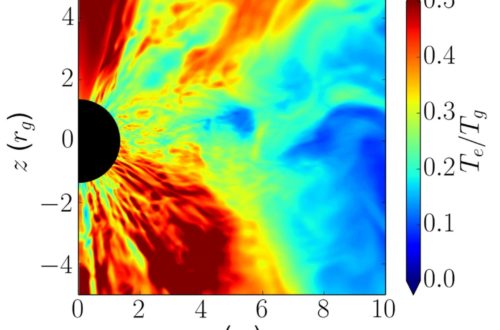This morning I came into work to read some super exciting news in my email! A gamma-ray burst (GRB) has been detected by ground based TeV facility MAGIC for the very first time, with extremely high significance! There has been an impressive multi-wavelength campaign to try to constrain more details of the source, and it seems to be extremely bright, almost 100 times as bright as the “typical” GRB. This is not surprising because the source, while somewhat nearby by GRB scales, is still many billions of light years away, so it had to be very bright or we would not have detected it.
If you want to read more about what GRBs are, see Deniz’s post from August, but basically these are the most powerful cosmic explosions we know of. We think that a lot of the emission is powered by relativistic jets, which are one of the main foci of our research group, and a phenomenon we see in many classes of objects, but all usually driven by an underlying black hole. Some of these GRBs are associated with two merging neutron stars, which thanks to LIGO/VIRGO observations in 2017, we now know are also sources of gravitational waves.
So why do I care? Well, I’ve posted several times in the past about one of the instrument projects I’m involved in, the Event Horizon Telescope, but now it’s time to talk about the other instrument project I work on, the Cherenkov Telescope Array, or CTA.
CTA (see https://www.cta-observatory.org/) is the next generation “very-high-energy” (VHE) telescope, which means it focuses on light that is so energetic that these massless photons’ energy becomes comparable to the kinetic energy of a relativistic particle. We also know that such photons have to be products of other massive particles like electrons and protons/ions that get accelerated to even higher energy in the sources, in fact millions of times higher than what labs on Earth like CERN can achieve. The processes that create those “parent” high energy particles are valuable probes for us, revealing the most extreme physical conditions possible in astrophysical objects. Because they are few and far between, we are not even sure which objects are capable of creating these high energy particles, thus gamma-rays in general, but VHE especially, are basically “smoking guns” of these processes. VHE is typically used for photons that are TeV or higher, where a TeV (tera-electron volt) photon is billions of times higher energy than what comes out of our sun, for example.
VHE astronomy is a very new field, pathfound by the Whipple Telescope when I was in grad school, and basically relies on using the same technique we use to detect the “parent” high energy particles, which is looking for optical Cherenkov light emitted when they interact with matter in our atmosphere. It turns out that when the massless photons are almost as high energy as their “parents”, they also create this optical signal in the atmosphere. Whipple proved this sort of detection could be done, but this field really only came into its own with the advent of H.E.S.S., which was the first facility that used multiple telescopes to enable tracing back multiple signals to the source direction, allowing the making of actual images in TeV gamma-rays for the first time. Now we also have two other VHE facilities, MAGIC and VERITAS. But the spatial resolution of this technique in general isn’t great, compared to typical optical and radio telescopes, and *definitely* not compared to the EHT! The resolution until now has been more or less that we can see details in something on the sky down to scales on the order of the size of the moon or a bit less. If you compare that to the size of a star on the sky you get the idea that this is pretty low resolution.
So the concept of CTA was born, which is to combine over 100 telescopes (compared to 5 with HESS2) of different sizes, and have one array in the north hemisphere and one in the south. In this way we can get ~10 times better spatial resolution and sensitivity, and also see a wider swath of the sky at a single pointing compared to the first facilities. We have already started construction and expect to be in early science in the next five years or so, with official operations beginning in 2025, which is really soon by astronomy standards!!
Coming back to why this observation is important: first of all there has been a long debate about whether GRBs can accelerate particles up to VHE (TeV), since until now all the GRBs have shown cutoffs in their spectra at energies somewhat lower, in the GeV range. These energies are still very interesting, but do not provide that smoking gun for the parent particles we are interested in, generically called ‘cosmic rays’. Now we know that at least some GRBs are definitely able to make these, so that’s really huge for the field of particle astrophysics, and now we need to re-assess our models and try to understand how exactly this process worked in this source, which luckily seems to have a lot of great multi-wavelength data along with the gamma-rays. This burst also opens up something of another mystery, because typically we do not think gamma-rays can survive traveling so far (from redshift z=0.4 to us). Usually they will collide along the way with photons floating around that were emitted by intervening stars, so this detection means something unexpected is going on.
But another reason I am excited is that it “proves” that CTA will see GRBs! We’ve been wondering about this since day one, and the expected rate of GRBs that make it up to TeV energies has been unknown until now, meaning our estimates were anywhere from one every 1000 years to several per year. Because CTA will see much deeper than other facilities and especially for fast transients like GRBs, we have expected that there might be a larger population lurking out there, but we had no way to be sure. Now we know they are there, and this gives us key benchmarks to re-assess our observing strategy, since part of the first years’ plan was to go out hunting for these things. Another wilder dream is to be the first to detect one of these sources in the VHE gamma-ray band, at earlier times than is currently now possible. Until now another facility (in this case it was transient finder SWIFT but often it is the Fermi GBM in MeV/GeV photons) has monitored the sky every night, and been the one to find a GRB, which then triggers TeV facilities. Until yesterday the existing TeV facilities looked but never found anything; but they were probably looking too late since these sources fade very fast. CTA will be 4-5 orders of magnitude (that’s 10000-100000x!) more sensitive than Fermi for such fast transients (less than an hour peak), so our hope is there is an entire population out there that we just haven’t been able to see before. This new detection bolsters this hope, and means that CTA is going to definitely find more GRBs, and maybe even be the first to discover a new class of them!



